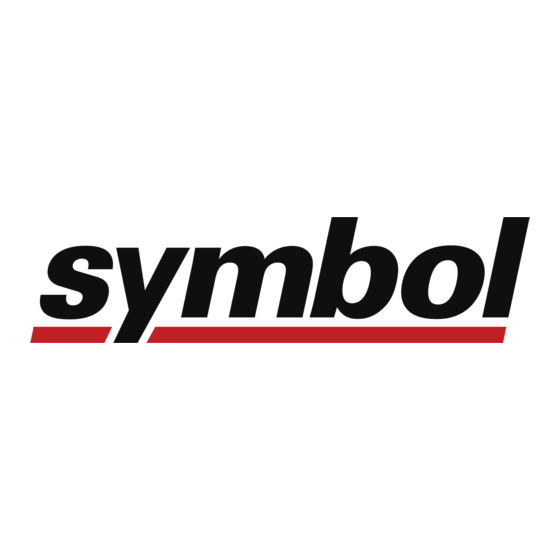
Table of Contents
Advertisement
Quick Links
Advertisement
Table of Contents

Subscribe to Our Youtube Channel
Summary of Contents for Symbol Mobile GATEWAY
- Page 1 SYMBOL MOBILE RS 2200/3200 Series GATEWAY Product Guide...
- Page 2 © 1996 SYMBOL TECHNOLOGIES, INC. All rights reserved. Symbol reserves the right to make changes to any product to improve reliability, function, or design. Symbol does not assume any product liability arising out of, or in connection with, the application or use of any product, circuit, or application described herein.
-
Page 3: Operating Environment
Introduction The Symbol Mobile Gateway (SMG) is a rugged computer designed to be used as a platform for in-vehicle communications and connectivity by Symbol portable data terminals. It provides wireless network communications and RS-232 flexibility. Description Operating Environment The SMG supports a DOS operating environment using industry standard protocols. -
Page 4: Input/Output Ports
Input/Output Ports One Type III and one Type II or two Type II PCMCIA slots behind cover WWAN WLAN 12/24 VDC COM 4 Keyboard COM 3 COM 1* COM 2 *COM 1 is shown as a nine pin RS-232 connector. Optionally, it may be configured as an RS-422 port utilizing an RJ45 connector. - Page 5 GPS Antenna - Global Positioning System for tracking vehicles and location assistance. A PCMCIA option which supports two Type II or one Type III and one Type II card for the Symbol Micro Access Point and/or other PCMCIA cards is available on SMG386 configurations only.
-
Page 6: Installation
Installation Warning Improper installation can cause damage to both the vehicle and the Symbol Mobile Gateway. Installation should be performed by an experienced technician. Required Parts 1. Two fuseholders - Alectron p/n ZC 210B 2. One fuse - 8 amp slo-blo Littlefuse p/n 313.008 3. - Page 7 To Install: 1. Select a mounting location that is flat and provides adequate support and ventilation for the SMG. Note: SMG chassis must be grounded to the vehicle chassis. 2. Secure the SMG with appropriate nuts and bolts. Self- locking nuts or lock washers must be used. 3.
- Page 8 4. Route the power cable to the battery power source. • Connect the V+ wire to the battery power source, splicing a fuse holder with an 8 amp fuse in-line with the power source. Note: Locate the fuse as close as possible to the battery power source.
- Page 9 Table 2. COM 1, COM2, COM3*, COM4* Port Pin-outs Pin No. Function Transmit Data Receive Data Request to Send Clear to Send Data Set Ready Ground Data Transmit Ready Ring Data Carrier Detect *COM3 and COM4 are optional COM1 can be configured as either an RS-422 or an RS-232 port. If configured as an RS-232 port, a female DB-9 connector is provided with port pinouts as described in Table 2...
-
Page 10: Application Notes
Application Notes Inactivity Monitor The inactivity monitor is designed to do an orderly shutdown of the SMG when the vehicle has been turned off for a period of time. Two versions are available: a custom hardware implementation and a generic implementation that is an application that runs on the SMG. - Page 11 Programmer Notes The status of the accessory power bus is available to the application at port 379H bit 7. The application software can periodically monitor this input and when loss of accessory power is detected, it can intelligently determine (based on customer criteria) if and when to shut down the SMG.
-
Page 12: Regulatory Information
Regulatory Information Radio Frequency Interference Requirements This device must operate in compliance with Federal Communications Commission (FCC) Rules and Regulations Part 15. This equipment has been tested and found to comply with the limits for Class A digital device, pursuant to Part 15 of the FCC rules. These limits are designed to provide reasonable protection against harmful interference when the equipment is operated in a commercial environment. -
Page 13: Canadian Compliance
(1) il ne doit pas produire de brouillage et (2) l’utilisateur du dispositif doit être prêt àaccepter tout brouillage radioélectrique reçu, même si ce brouillage est susceptible de compromettre le fonctionnement du dispositif. Please contact your local Symbol Technologies, Inc. representative for support and service. Symbol Technologies, Inc. -
Page 14: Warranty Information
This warranty is limited to repair or replacement at Symbol’s option, with reasonable promptness after being returned to Symbol by a carrier selected and paid for by the customer. These provisions do not prolong the original warranty term for any product which has been repaired or replaced by Symbol.

Need help?
Do you have a question about the Mobile GATEWAY and is the answer not in the manual?
Questions and answers